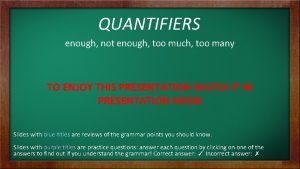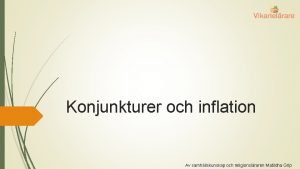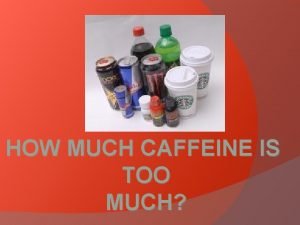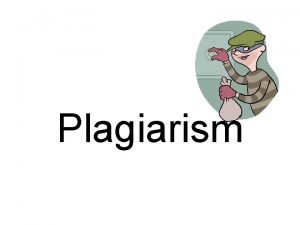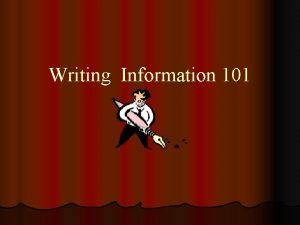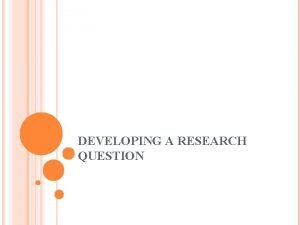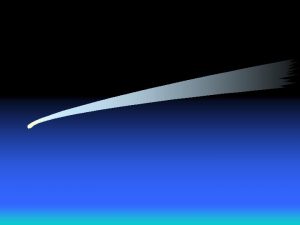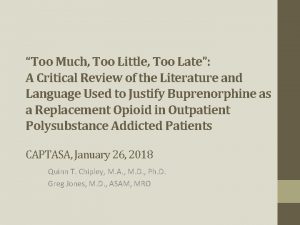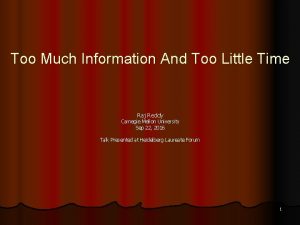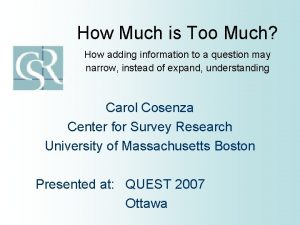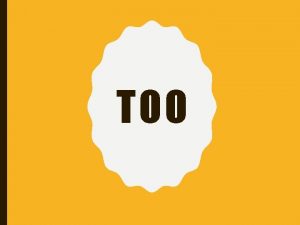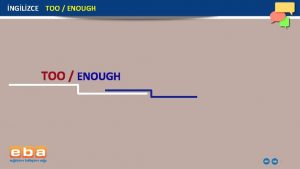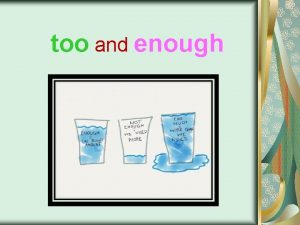Too much information Visualization agents that see the










- Slides: 10

Too much information Visualization agents that see the “diamonds on the dust” Karen Gundy-Burlet (NASA Ames) Johann Schumann (RIACS) Tim Menzies (WVU) 2/2/07

May your wishes never come true Olde world: never enough information to make decisions l New world: analysts overloaded with data by simulations from l Supercomputers – Cheap LINUX clusters – l Situation is going to get worse – More and more network CPU available SETI project l Grid computing l l How to handle all that data?

Cognitive Overload l Consider this 5 -D plot X, y, z – Visual cues for rotational momentum. – Colors used for density – And additional dimensions shown bottom right – l Consider the problem of exploring all these dimensions Jump on in – Move those sliders around – Have you missed anything? – Does your exploration of this space suffer from “greedy search? ” (miss a global optimum? ) –

What happens in higher dimensional space? l E. g. Constellation re-entry simulation – Already in 24 -dimensions l One for every setting to the input specs Produces wide range of behavior l Visualizations need agents l To cut through the maze of interactions – Return the core ideas –

Does clustering help? l Constellation re-entry: 24 dimensions, – l We can cluster them according to domain knowledge – l (24^2 - 24/2 = 276 sets of interactions E. g. distance to target But we don’t know the minimum we need to do to access the different clusters

Does treatment learning help? l Treatments = least set of factors that most change the outcome – E. g. if sick, your doctor can instantly, schedule surgery Or, take your temperature l and ask if other people where you work have the flu. l – l One of these actions leads to more cost-effective solutions. Out of 276 settings, treatment learner It found two that most selected for finding the targets – But it missing the middle region – l treatment learning knows about rectangles, not stripes

So, what to do l l l Different methods offered solutions to part of the problem Clustering : defined the space Treatment learning: focused the analysis Visualization: displayed, suggested new insights (e. g. add a new slanted dimension). Iterate: Cluster focus display, apply new insights – Repeat –

Benefits l l l More data, understood faster More exploration of models Less effort in examining results A structured methodology for inspecting data An audit trial for why certain decisions were made Clustering pointed us to “this”; – treatment learning revealed “that”, – so we explored “the other thing” –

Extensions l After doing the above on NASA data, we see ways to do the above – l In real-time So – – – Not simulate, then study But study why you simulate. Data miners (clustering, treatment learners) can be queried not just for a learned theory l – Make better use of our simulators l l But for hints on what would be the next best sim to run Not just more data, but more focused data Can be done before or after launch. – – – Fly an agent on the rocket Offers back to ground control the most crucial issues to look at. An in-flight V&V agent in a box.

Deliverables l 6 months – Scripts, integrated into XYZ simulation (say, TRICK, or whatever) l l 9 months – l As above, plus dimensionality synthesis tools (e. g. PCA to find that diagonal stripe). 12 months – Tool (version 0. 1): An n-dimensional display with added information from the treatment learning l l Automatic clustering, treatment learning, automatic generation of a small number of graphs showing most important regions Here, there be dragons 24 months – – Tool (version 1. 0). The above tool, augmented l l with a real-time visualization agent that surfs the space the user Pointing out features you may have missed
 Kahoot enough too
Kahoot enough too Högkonjuktur inflation
Högkonjuktur inflation How much caffeine is too much
How much caffeine is too much How much is too much plagiarism
How much is too much plagiarism Too broad and too narrow examples
Too broad and too narrow examples Too broad too narrow
Too broad too narrow Research questions
Research questions Too broad and too narrow examples
Too broad and too narrow examples Just about right scale
Just about right scale Too foreign for here too foreign for home
Too foreign for here too foreign for home Too blessed to be stressed too anointed to be disappointed
Too blessed to be stressed too anointed to be disappointed
